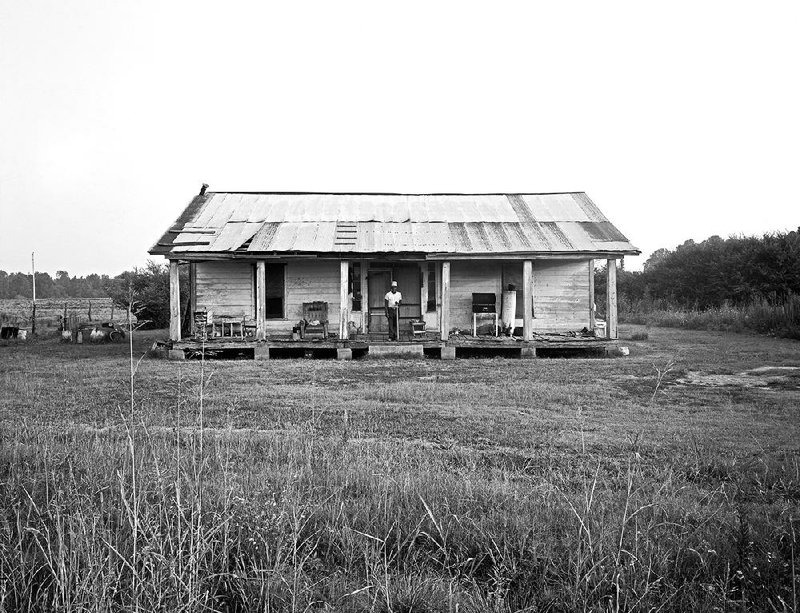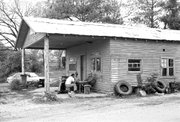"It's about beautiful things that have disappeared, about the ruin of our own culture," says photographer Geoff Winningham. He's talking about his book Of the Soil, a collaboration of the University of Arkansas Press and the UA Fay Jones School of Architecture.
The saga of how the book came to be is the subject of a recent lecture by Winningham, professor and Lynette S. Aubrey Chair in the Humanities at Rice University in Houston, presented by the Architecture and Design Network at the Arkansas Arts Center.
"In March 1980 I came to Little Rock to meet with H. Charles Johnson, then president of First Federal Savings and Loan of Arkansas, who wanted photos of everyday stuff," says Winningham--stuff like Arkansas barns, stores, silos, churches, houses, hotels and other common buildings. The photos were to hang in First Federal's nearly-completed modern office building.
A fan of the work of Henri Cartier-Bresson, who is considered to be responsible for establishing photojournalism as an art form ("his book One Decisive Moment changed my life"), Winningham could hardly wait to get started. "You hope for a commission like this."
Johnson wanted 100 photos. He wanted a photographer who could take black-and-white pictures with a large format camera. Winningham didn't have the big camera, but instead of admitting that to Johnson, he bought a large-format 8 x 10 Deardorff and was introduced to Cyrus Sutherland, a longtime preservationist and professor of architecture at the University of Arkansas. Sutherland knew a thing or two about vernacular architecture, defined as everyday structures built by and for ordinary people--architecture without architects. And he knew where to find it. So the two hit the road with Sutherland as guide. And Winningham took some pictures with that big-format camera.
"One of them was a wood-frame octagonal barn in Washington County," Winningham recalls. "Then, east of Mineral Springs in Howard County, there was the most beautiful Greek Revival cottage in existence. Dogtrot houses and shotgun houses; Cy knew where to find them. If a person was connected, I tried to get them in the picture"--men playing dominoes beneath a store overhang, a kid on a stool in a doorway, dogs trotting across a yard, a man holding a goose while standing on a front porch.
"We delivered the photos in June 1981, just before the S&L crisis hit," says Winningham. "That was the end. I drifted away from the project in 1983; I didn't know how to finish it. I'd photographed 3,000 structures and had 10 binders of negatives. But I didn't have a story. I didn't know how to shape the photos. They sat for 30 years."
In 2009, a year after Sutherland died, "I bought a digital scanner and went through 528 negatives that looked better than the rest and made proof prints," Winningham says. "I put them in groups modeled after The Inhabitants by Wright Morris [published in 1946], with text and photos meshed. I wanted this book to look like that."
With help from historic preservationist Parker Westbrook, whose family had settled generations ago around Nashville, Ark., Winningham had to go back and find many of the buildings to make it all come together. "Buildings as they begin to fall attract me," he says. In this case, that meant that many of the structures he photographed were no longer there. But that helped him find the book's narrative--the fact that the buildings are going away.
"I started to talk to people about the buildings," he says--what they remembered, what happened when they were there. "I'd collected 40 interviews and condensed 28 into stories shaped by me. These photographs belong in a book of words."
The stories bring a human element to many of the starkly elegant pictures, such as this paragraph by a woman who grew up in that Greek Revival cottage in Mineral Springs with her grandparents, her four siblings, and her grandparents' other seven children:
I remember we used to eat what we called the clay dirt. Just walking down the road, if we saw some of the clay dirt, we would eat some if it, because that's what we learned from our parents. That's what they had been taught to do, and then of course they taught us. That was just part of country life, and my kids today don't like anything about country life. They despise living in the country.
The finished product, aided by grants from the Arkansas Humanities Council that allowed Winningham to complete his research, was published by UA Press in August. Winningham has appeared at several book-signing events in the state since then.
"I always feel welcome in Arkansas," he says, although he admits to being a bit intimidated about discussing his work in front of a lecture hall filled with some of the state's most renowned architects--despite the fact that his evocative photographs are in major U.S. collections including the Museum of Modern Art and the Metropolitan Museum of Art. "I'm still excited after 50 years of photography. I started taking pictures as a 13-year-old. Photography makes me feel connected to things I want to explore."
Editorial on 12/21/2014

